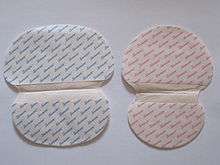Underarm liners
Underarm liners are an alternative to antiperspirants. The liners are applied directly to clothing. They contain absorbent material that wicks away moisture from sweat, keeping the axilla dry. Underarm liners were used more commonly before chemical antiperspirants, primarily by women, to preserve fine dresses from soiling. Sweat contains substances that stain yellow or fade dyes. Underarm liners are also known as underarm shields, underarm pads, sweat guards, dress shields,[1] and pitty protectors.[2]
History
For centuries, bathing was far from common in many parts of the world. Heavy colognes were used to mask body odor. Not until the late nineteenth century did chemists develop products that prevented the formation of body odors. Early antiperspirants included creams, solids, pads, dabbers, roll-ons, and powders. Today, anti-perspirant sticks are most common. But an older form of sweat protection, underarm liners, never went away.[3][4]
Reusable underarm liners

The traditional reusable (or washable) liners are less common today. Typically used only by women, the liner secures to the underarm area of the garment via an adjustable strap on a bra. Reusable liners consist of double ply cotton on one side and either a nylon or vinyl barrier on the other side. The cotton side rests on the actual skin of the armpit while the vinyl or nylon rests on the clothing as the final barrier, preventing any sweat from reaching the garment.
Disposable underarm liners
Disposable liners are offered for men and women. The thin liner is a "peel and stick" product the user places directly onto the inside of the garment. One side of the liner consists of a plastic barrier with a layer of purposely formulated glue. The other side of the liner is the absorbent side. Constructed with air-laid paper, it rests against the skin of the armpit and absorbs the moisture.
See also
References
- ↑ Cobb, Linda (2002). How the Queen Cleans Everything. SImon and Schuster. p. 289. ISBN 978-0-7434-5145-1.
- ↑ Ketal, V. "Dress Shields for Safety". miaaow. Retrieved 19 November 2015.
- ↑ Laden, Karl (1999). Anti-Perspirants and Deodorants, Second Edition. CRC Press. ISBN 978-0-8247-1746-9.
- ↑ "Antiperspirant/Deodorant Stick". How Things Are Made.